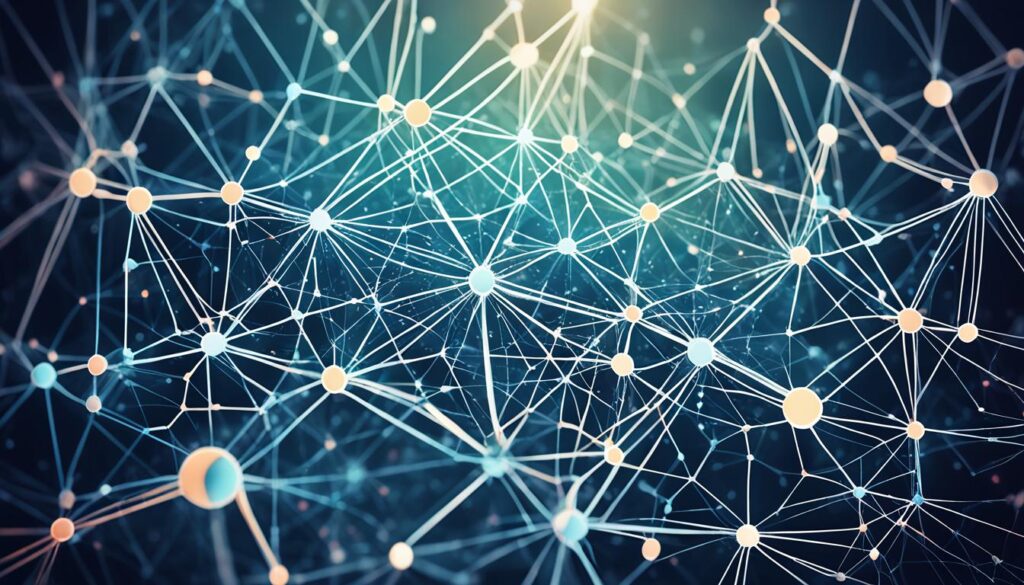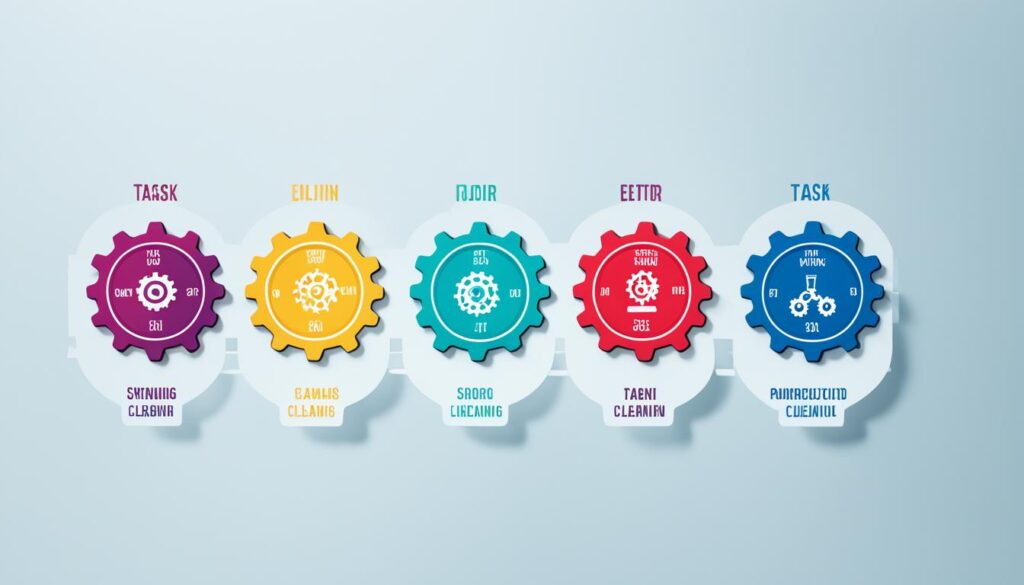“As an Amazon Associate I earn from qualifying purchases.” .
Imagine entering a sparkling clean office at dawn, where the air is fresh. Every surface is spotless, but there’s not a custodian in sight. This amazing scene is no longer just from futuristic movies.
The rise of AI technology is starting to change our world. This change is happening in places we might not think about, like cleaning services.
Meet Janitor AI, a cutting-edge AI technology in cleaning. It’s set to change how we think about and do cleanliness. Janitor AI uses high-tech sensors, cameras, and smart algorithms. It turns regular cleaning jobs into a hands-free, efficient system.
This new tech boosts how much work we get done. It also changes how we clean based on different floors and situations. This prepares us for a new age of cleaning, where machines do more of the work.
Key Takeaways
- Janitor AI offers potential for massive time and resource savings by enabling non-stop operation.
- Equipped with sensors, these machines can navigate complex floor plans and ensure thorough cleaning.
- AI technology in cleaning improves hygiene and reduces accident risks by quickly detecting and addressing spills.
- Energy-efficient and eco-friendly, Janitor AI aligns with sustainability goals by minimizing harsh chemical use.
- Although initial investment and maintenance costs are high, the long-term benefits promise substantial returns.
Introduction to Janitor AI
Janitor AI is at the forefront of cleaning industry innovation. It combines artificial intelligence with traditional cleaning services. The goal is to make cleaning more seamless, efficient, and effective. It significantly boosts productivity, safety, and overall cleaning quality.
What is Janitor AI?
Janitor AI merges AI-powered cleaning with usual janitorial tasks. It uses sensors, cameras, and smart algorithms to clean on its own. These systems clean differently based on the space and its conditions. This leads to accurate and reliable cleaning, lowering mistakes and human effort.
How AI is Used in Janitorial Services
Janitorial artificial intelligence is critical in various cleaning tasks. Janitor AI can understand emotions and adapt to different cleaning needs. It picks up on the customer’s feeling to provide the best cleaning service.
Janitor AI also shines in managing cleaning data. It ensures that the cleaning data collected is accurate and complete. This is essential for using data in intelligent ways.
| Use Cases | Benefits |
|---|---|
| Cleaning and organizing unstructured data | Lower costs, greater productivity |
| Correcting inaccuracies within data sets | Reduced human errors |
| Detecting missing values | Improved data-driven processes |
| Cross-tabulating data | Support with web scraping and data collection |
| Rectifying duplicated or conflicting data | Optimized cleaning precision |
These AI developments are a big step in the cleaning world. The new chat feature in Janitor AI makes conversation more natural. It’s great for chatbots or for fun. Using AI in cleaning brings big gains in how clean and efficient places can be.
How Janitor AI Works
Janitor AI is a big step forward in cleaning tech. It uses advanced sensors, cameras, and smart algorithms to offer better cleaning. This tech lets Janitor AI work alone, clean all sorts of places, and find dirt with precision.
Integration of Sensors and Cameras
Sensors in AI are key for Janitor AI to work well. With high-quality cameras, it maps and moves through spaces exactly. These sensors find dirt and see even the smallest bits that usual cleaning might miss. Also, the cameras help the machine make live changes to how it cleans, ensuring a spotless job.
Advanced Algorithms and Machine Learning
Janitor AI also uses AI algorithms for janitorial services. These algorithms use machine learning in cleaning to get better over time. This learning helps the machine adjust its cleaning style, meet different needs, and find the best cleaning routes. So, Janitor AI keeps getting smarter, perfect for many cleaning situations.
| Feature | Benefit |
|---|---|
| Sensors and Cameras | Accurate navigation and dirt detection |
| AI Algorithms | Enhanced performance through continuous learning |
| Machine Learning | Adaptability to new environments and varied cleaning requirements |
| Multi-Channel Integration | Seamless integration across websites, messaging apps, and social media platforms |
Janitor AI changes the game in cleaning. It brings top tech, like sensors in AI and AI algorithms for janitorial services. This makes it super efficient and great for all kinds of places. Businesses that use this tech see fewer cleaning mistakes, smarter use of resources, and cleaner, safer areas.
Benefits of Implementing Janitor AI
Putting AI into janitorial services offers many pluses. It makes cleaning more efficient, safer, and cheaper. These systems use top-notch AI to boost work speed, cleanliness, and the environment.
Enhanced Efficiency and Productivity
Janitor AI greatly cuts down on efficiency in janitorial services. It does routine clean-up jobs automatically, non-stop. This means places stay clean all the time, not just when people can work. It lets staff work on more important things, improving the value they add.
Hygiene and Safety Improvements
It also makes a big difference in AI hygiene improvements. AI tools spot messes quickly with their smart sensors and cameras. This leads to fast cleaning up, keeping places safer. Clean-ups are always thorough which is vital in places like hospitals and food areas.
Cost-Effectiveness and Sustainability
Janitor AI is a win for the budget and the planet. It uses less power than usual cleaning gear and cuts down on harmful chemicals. This saves money and helps the earth, suiting organizations that value sustainability.

Overall, Janitor AI is a game changer for the cleaning sector. It amps up efficiency, cleanliness, and green practices. This puts it ahead in the world of cleaning services.
Challenges Faced by Janitor AI
Janitor AI is a big step forward, but it’s not without its problems. It faces issues, from economic hurdles to social impacts. These need careful thought to blend well in the cleaning world.
Initial Investment Costs
Getting janitor AI set up requires a big investment due to its high-tech nature. Companies have to think about spending now for later benefits. The big start-up cost might stop some from using this new tech.
Maintenance and Operational Challenges
Keeping janitor AI running smoothly is not simple. Maintenance needs special skills and ongoing care. The machines’ complexity might bring up problems, affecting cleaning routines. This makes it important for experts to quickly fix any issues.
Job Displacement and Societal Implications
The social effects of automated cleaning are vital too. With AI doing basic chores, jobs in cleaning could be at risk. This could have big effects, like needing to retrain workers and deal with job loss. But, it might also create tech jobs for maintaining the AI.
“The text raises concerns about how difficult it might be to detect collusion in advance, especially with superhuman AIs that could potentially mask their intent and leverage creative capabilities.”
Read more about AI safety and the janitor bot problem
Natural Language Processing in Janitor AI
NLP greatly enhances Janitor AI‘s abilities. It helps the system understand complex cleaning needs. By looking at how words are used together, it gives better answers to what users ask.
Janitor AI uses NLP and machine learning to process data. It’s great at tasks like analyzing data and making it organized. This makes it really good at answering questions and getting things done quickly and well.

Role of NLP in Understanding Cleaning Requirements
NLP is key in helping Janitor AI get at what people want when it comes to cleaning. It looks at the words people use to figure out the best way to clean. This way, it can do even tough jobs just right.
NLP, paired with machine learning, helps Janitor AI get better at what it does over time. It gets smarter with every task. This allows Janitor AI to talk with users in all kinds of new and helpful ways, making sure everyone gets what they need.
Improving User Interaction with AI Systems
Using NLP in Janitoral Technology makes it easy for everyone to talk to Janitor AI. You don’t need to be a tech expert to chat with it. This makes using the technology simple and fun for everyone.
Janitor AI can talk in ways that really connect with people. It seems like it understands how we feel. This makes talking to Janitor AI a better experience. People feel like they’re really being heard and helped, which is great.
Also, Janitor AI is good at pulling info off the web for you too. It can find and organize data using NLP, face and image recognition, and other cool tools. This makes it even more useful for getting jobs done well.
- Accuracy: Janitor AI gets what you’re asking for right, so it gets the job done well.
- User-Friendliness: It’s easy for anyone to talk to Janitor AI. You don’t have to be a computer expert to use it.
- Efficient Data Handling: Janitor AI makes data neat and organized using NLP and ML.
In short, NLP has changed how we use AI for cleaning. It makes talking to AI easier and getting tasks done better. This is thanks to improving how AI understands what we need and leading to better communication.
| Benefits of NLP in Janitor AI | Description |
|---|---|
| Enhanced Understanding | Accurate interpretation of complex cleaning instructions through sentence structure and context analysis. |
| Improved User Interaction | Allows seamless communication with AI using natural language, making the technology accessible to non-technical users. |
| Continual Learning | ML algorithms enable Janitor AI to learn and improve responses over time, tailoring to user needs. |
| Innovative Responses | Generative AI translates inputs into suitable or creative responses, enhancing user experience. |
Data Cleaning and Text Preprocessing
Improving janitor AI starts by cleaning up data. This way, advanced algorithms can work well. The AI then does its job better in different situations.
Importance in Janitor AI Performance
Data cleaning is key for janitor AI’s accuracy and trustworthiness. Many businesses use process automation to ensure data quality. This keeps janitor AI running smoothly.
Methods and Techniques Used
Inspecting data manually is still crucial for reliable outcomes. Programming languages such as Python, R, and SAS help automate this. They use tools like tidyverse, pandas, and dplyr for effective data cleanup.
For more specific data needs, tools like janitor in R and pyjanitor in Python are valuable. Industry tools like RapidMiner assist as well. It’s recommended to use pipelines for better organization and execution.
| Programming Language | Libraries/Packages | Recommended Use |
|---|---|---|
| Python | pandas, pyjanitor | Data Cleaning |
| R | tidyverse, janitor | Data Cleaning |
| SAS | dplyr, proc standard | Text Preprocessing |
| Tools | RapidMiner, TIBCO Spotfire | Data Cleaning |
Lastly, ensuring clean data is accurate is crucial. Thorough testing and validation are necessary. This guarantees data is ready for analysis.
Predictive Modeling in Janitor AI
Predictive modeling is key for Janitor AI to improve automatic cleaning. It uses data analysis to guess when maintenance is needed. This stops big problems and makes everything work smoothly, saving time and money.

Automated Maintenance and Issue Detection
Janitor AI uses advanced technology to spot problems early. This means it can fix small issues before they get big. With AI, robotic cleaners are smart, efficient, and can clean all sorts of places. They work on their own, improving how cleaning is done in a sustainable way.
Optimizing Cleaning Schedules
Janitor AI also makes cleaning schedules better. It checks when areas are used most and the conditions there. Then, it picks the best times to clean, saving resources and increasing efficiency. Connecting IoT to Janitor AI makes this even more precise, ensuring cleaning happens right when it’s needed.
Feature Engineering for Janitor AI Systems
Feature engineering is vital for Janitor AI systems. It helps them learn better and become more efficient in their cleaning tasks. By tuning specific attributes, Janitor AI gets better at understanding and dealing with data.
Enhancing AI Capabilities
Janitor AI uses powerful algorithms to get better at its job. After being trained, it can fill in missing data, sort information correctly, and spot unusual data. It works well and safely on many types of data, like what’s found on websites, apps, and social networks.
Customizing Cleaning Solutions
Janitor AI lets users change how the chatbots look and talk. Users can also set rules for cleaning data in a way that fits their needs. It’s easy for anyone to start using it for free, make their chatbots unique, and set up data rules. Adding API keys from platforms like OpenAI or Kobold AI makes these cleaning solutions even more specific and helpful.
FAQ
What is Janitor AI?
How is AI used in janitorial services?
What role do sensors and cameras play in Janitor AI?
How do advanced algorithms and machine learning contribute to Janitor AI?
What are the benefits of implementing Janitor AI?
What are the initial investment costs for Janitor AI?
What are the maintenance and operational challenges of Janitor AI?
Could Janitor AI lead to job displacement?
How does Natural Language Processing (NLP) enhance Janitor AI?
Why are data cleaning and text preprocessing important for Janitor AI performance?
How does predictive modeling benefit Janitor AI?
What is feature engineering in the context of Janitor AI?
Source Links
- https://www.toolify.ai/ai-news/experience-the-unbelievable-power-of-janitor-ai-in-revolutionizing-cleaning-2357580
- https://rayobyte.com/blog/what-is-janitor-ai/
- https://www.linkedin.com/pulse/how-use-janitor-ai-guide-blockchaincouncil-2hwqe
- https://www.gate2ai.com/tools-review/janitor-ai-review.html
- https://medium.com/@moneytent/how-janitor-ai-can-simplify-your-data-cleaning-process-and-boost-productivity-7b179225d3ab
- https://community.openai.com/t/ai-safety-the-janitor-bot-problem/712575
- https://scrapingrobot.com/blog/what-is-janitor-ai/
- https://www.linkedin.com/advice/3/how-do-you-automate-streamline-your-data
- https://dotcommagazine.com/2023/11/janitor-ai-a-must-read-comprehensive-guide/
- https://www.blockchain-council.org/ai/how-to-use-janitor-ai/
- https://apkfilemaster.medium.com/janitor-ai-not-loading-tips-and-solutions-2a76d90249a
“As an Amazon Associate I earn from qualifying purchases.” .



